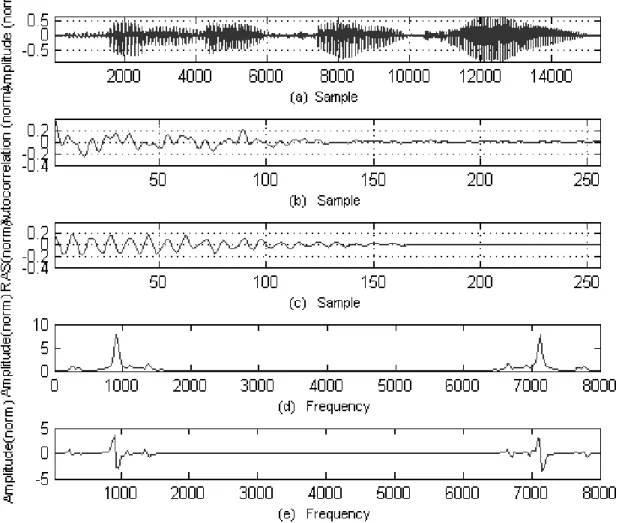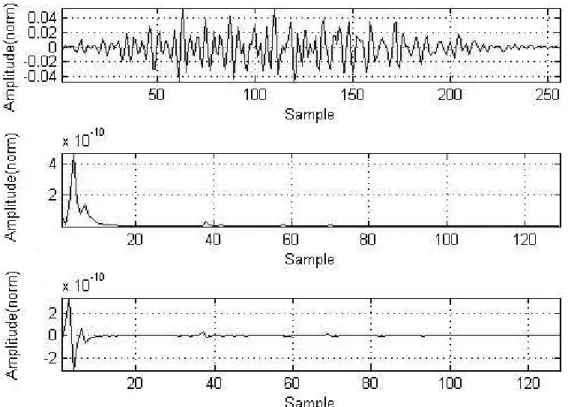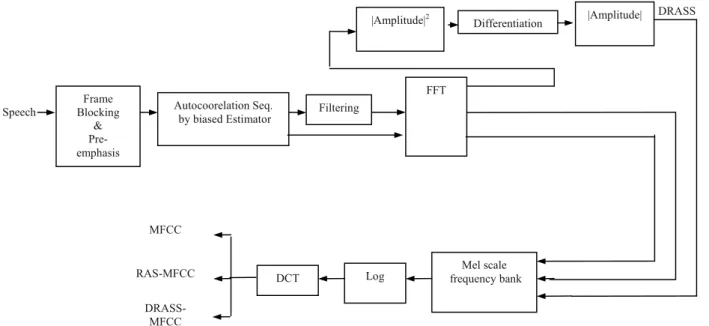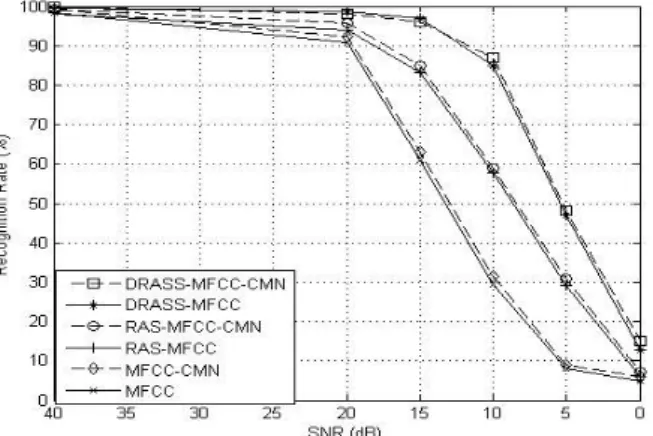Role of Spectral Peaks in
Autocorrelation Domain for
Robust Speech Recognition
Poonam Bansal
1, Amita Dev
2and Shail Bala Jain
31Department of Computer Science and Engineering, Amity School of Engineering and Technology, New Delhi, India 2Department of Computer Science and Engineering, Ambedkar Institute of Technology, New Delhi, India
3Department of Electronics and Communication Engineering, Indira Gandhi Institute of Technology,
Guru Gobind Singh Indraprastha University, New Delhi, India
This paper presents a new front-end for robust speech recognition. This new front-end scenario focuses on the spectral features of the filtered speech signals in the autocorrelation domain. The autocorrelation domain is well known for its pole preserving and noise separation properties. In this paper, a novel method for robust speech extraction is proposed in the autocorrelation domain. The proposed method is based on a novel rep-resentation of the speech signal corrupted by an additive noise. Initial filtering stage is used to reduce the additive noise when computing the speech features followed by extraction of the autocorrelation spectrum peaks. Robust features based on these peaks are derived by assuming that the corrupting noise is stationary in nature. A task of speaker-independent isolated-word recognition is used to demonstrate the efficiency of these robust features. The cases of white noise and colored noise such as factory, babble and F16 are tested. Experimental results show significant improvement in comparison to the results obtained using traditional front-end methods. Further enhancement has been done by applying cepstral mean normalization(CMN)to the above extracted features.
Keywords: robust speech recognition, autocorrelation domain, spectral peaks
1. Introduction
Noise robustness is one of the most challeng-ing problems in automatic speech recognition. The performance of automatic speech recogni-tion(ASR)systems, trained with clean speech, may drastically degrade in realistic environ-ments. The main reason for this degradation is the acoustic mismatch between the training and testing environments due to environmental effects. Many techniques have been proposed
Although these techniques demonstrate the com-parable performance, some weaknesses may restrict their practical applications. The SS method suppress the background noises by first estimating non-speech intervals followed by their subtraction from the noisy speech. Recently, the parameters extracted using autocorrelation se-quence of the noisy signal have been found use-ful for robust speech recognition. Some exam-ples include magnitude spectrum of higher lag autocorrelation coefficients [13]whereas other methods are based on Relative Autocorrelation Sequence(RAS)method[14,15]. Furthermore, according to[16], preserving spectral peaks is very important in obtaining a robust set of fea-tures in the speech recognition.
In this paper we propose a new approach, uti-lizing peaks obtained from the autocorrelation spectrum of the speech signal. This approach preserves the autocorrelation spectral peaks. We propose the following front-end description for robust feature extraction. Firstly, we calculate the autocorrelation of the noisy signal. As the temporal autocorrelation of noise is a DC or slowly varying signal, its effect is suppressed by a high-pass filter, such as RAS filter [15]. Then, following the DPS concept, relative au-tocorrelation sequence spectrum is computed from RAS and differentiated with respect to frequency. This new spectrum is referred to as differentiated relative autocorrelation sequence spectrum (DRASS). Finally, from the magni-tude of DRASS, the mel-scale frequency cep-stral coefficients(DRASS-MFCC) are derived by passing the DRASS through a mel-frequency filter-bank followed by the discrete cosine trans-form(DCT).
We can exploit properties of CMN, and combine the proposed robust features DRASS-MFCC with the CMN to further improve the recogni-tion accuracy. The features based on our method are showing remarkable increase in recognition accuracy, especially in noisy environments. The remainder of this paper is organized as fol-lows. Mathematical fundamentals for extract-ing RAS and DRASS are derived in Section 2. Proposed method with front-end diagram is de-scribed in Section 3. In Section 4. experiments conducted in clean and noisy environment with different front-ends are discussed and compared with the proposed front-end method. Finally a conclusion is given in Section 5.
2. Robust Features Extraction
2.1. Calculation of the Autocorrelation for Noisy Signal
Any noisy speech signaly(m,n)can be written as
y(m,n) =x(m,n) +u(m,n),
0≤m≤M−1, 0≤n≤N−1 (1)
where u(m,n) is the additive noise, x(m,n)
noise-free speech signal, N is the frame length (in our case 256 samples),nis the discrete time index in a frame,mis the frame index andMis the number of frames.
Ifx(m,n)andu(m,n)are assumed uncorrelated, then the autocorrelation of the noisy speech can be expressed as
ryy(m,k) =rxx(m,k) +ruu(m,k),
0≤m≤M−1, 0≤k≤N−1 (2)
whereryy(m,k),rxx(m,k)andruu(m,k)are the short-time autocorrelation sequences of the noisy speech, clean speech and noise, respectively, and k is the autocorrelation sequence index within each frame.
The one-sided autocorrelation sequence of each frame can be calculated using a biased estimator as:
ryy(m,k) = N−1−k
i=0
y(m,i)y(m,i+k),
0≤k≤N−1
(3)
Since additive noise is assumed to be stationary, its autocorrelation sequence can be considered to be identical for all frames. Hence the frame index,m, can be dropped out, and(2)becomes
ryy(m,k) =rxx(m,k) +ruu(k),
0≤m≤M−1, 0≤k≤N−1 (4)
2.2. Filtering of One-sided Autocorrelation Sequence
the noise effect is suppressed by calculating the Relative Autocorrelation Sequence(RAS). The RAS of the noisy speech at themth index can be found by applying a high pass filtering in the time domain to reduce the effects of addi-tive noises on signal(4)for all indicesmandk. Hence consider the differences
Δryy(m,k) =Δrxx(m,k),
0≤m≤M−1, 0≤k≤N−1 (5)
where
Δryy(m,k) =ryy(m+1,k),ryy(m−1,k)
and
Δrxx(m,k) =rxx(m+1,k),rxx(m−1,k) The sequence,{Δryy(m,k),0≤k≤N −1}, is referred to as the RAS of the noisy speech at the
mthframe. Denote the output of this temporal
filtering in the time domain asZ(m,n), we can write
z(m,n) =x(m,n) +v(m,n),
0≤m≤M−1, 0≤n≤N−1 (6)
wherex(m,n)andv(m,n)are the clean speech and the remaining noise after filtering, respec-tively.
2.3. Extraction of DRASS
The autocorrelation function of the filtered speech signal given in(6)can be written as
rzz(m,k) =rxx(m,k) +rvv(m,k),
0≤k≤N−1 (7)
Provided that the noise and the clean speech signal are assumed mutually uncorrelated, we
Figure 1.(a)A sample speech signal(b)Autocorrelation magnitude of a 16 msec. frame(c)Relative autocorrelation magnitude of a 16 msec. frame(d)Relative autocorrelation power spectrum of 16 msec. frame(The power spectrum
Figure 2.(a)A sample speech signal, and(b)the autocorrelation spectrum magnitude and the differentiated autocorrelation spectrum magnitude of the same signal with a 256-point FFT. For clarity, only 128 points of the
spectrum are shown.
can calculate the relationship between relative autocorrelation power spectrum of noisy speech signal, clean speech signal and noise by using short time DFT to both sides of equation(7), as follows:
DTF{rzz(m,k)}=DTF{rxx(m,k)}
+DTF{rvv(k)}, or
Z(ω) =X(ω) +V(ω)
(8)
Where DFT[ ]denotes the discrete Fourier trans-form, andω is the frequency in radians. Fur-ther enhancement can be obtained by comput-ing differentiation of the relative autocorrelation power spectrum for extracting spectral peaks. The differential power spectrum is defined as:
DZ(ω) = dZd(ωω) = dXd(ωω) + dVd(ωω)
=DX(ω) +DV(ω)
(9)
Where DX(ω) and DV(ω) are the differen-tial relative autocorrelation power spectra of the clean speech signal and the noise respec-tively. DZ(ω) is referred to as the Differenti-ated Relative Autocorrelation Sequence Spec-trum(DRASS)of noisy speech.
This approach combines advantages of RAS and DPS. Figure 1(a)depicts a sample speech signal, its autocorrelation magnitude (b) and relative autocorrelation magnitude(c) for a 16 msec. frame. Figure 1 clearly shows that ini-tial filtering in terms of RAS retains the signal information and filters out the additive noise at primary level. Figure 1(d)and 1(e)show rela-tive autocorrelation spectrum and the differenti-ated relative autocorrelation spectrum estimdifferenti-ated by the 256-point DFT. As shown in the Figure 1 and Figure 2, by differentiation the flat parts of the spectrum are transformed to values that are approximately zero. The spectral peaks are preserved, except each peak is split into the pos-itive and negative parts. The spectral peaks that convey the most important information in the speech signal are preserved, and thus, no im-portant information is lost in the process.
3. Description of the Proposed Method
frames of 256 samples each, and a pre-emphasis filter is applied on each frame. A Hamming window is used, and then, the autocorrelation sequence of the frame signal is obtained using a biased estimator, as given by eq.(4). A tempo-ral filtering is then applied to the autocorrelation sequence to obtain the relative autocorrelation sequence (RAS) in order to suppress the ad-ditive noise. When speech is corrupted by an additive noise, the noise component is additive to the speech not only in the autocorrelation do-main, but also in the power spectrum domain. In the next step, differentiated relative autocorrela-tion sequence spectrum(DRASS)is calculated by taking the differentiation of the power spec-trum of the relative autocorrelation coefficients (RAS). Differentiation of the autocorrelation spectrum of the noisy speech signal preserves the spectral peaks, however, each peak has now positive and negative parts. In addition, the flat part of the power spectrum is approximately zero. Figure 2 depicts a sample speech signal, its short-time autocorrelation spectrum and the differentiated short-time autocorrelation spec-trum. This sample signal corresponds to one frame of sample speech. In order to simplify the spectrum representation, only the signifi-cant lower-frequency parts of the spectrum have been shown and the non-significant parts have been omitted. As shown in Figure 2 and as men-tioned above, the flat parts of the filtered auto-correlation spectrum have been transformed to zero by differentiation and each peak has two
parts, positive and negative. Since the spectral peaks convey the most important information in the speech signal, this fact that the differential power spectrum retains spectral peaks means that we will not lose the important information of the speech signal. Furthermore, since the noise spectrum is often flat and the differenti-ation either reduces or omits the relatively flat parts of the spectrum, it will lead to omission of the effect of the noise on the signal lead-ing to more robust features. A set of robust mel-frequency cepstral coefficients ( DRASS-MFCC)can be derived from the magnitude of the differentiated relative autocorrelation power spectrum by applying it to a conventional mel-frequency filter-bank and finally passing its log-arithm to the DCT block. MFCC feature vector set of dimension 39 is formed by concatenating energy feature, Delta MFCC and Delta-Delta MFCC. CMN (Cepstral mean normalization) is used for removing the effect of channel dis-tortion on robust feature vector set. Figure 3 displays the proposed front-end diagram of our method.
4. Experiments
A digital database of 200 Hindi words spoken by 30 speakers(Table 1)has been used for the ex-periment of speaker- independent isolated word recognition system.
Mel scale frequency bank Log
Frame Blocking
& Pre-emphasis
Autocoorelation Seq.
by biased Estimator Filtering
FFT
Differentiation
|Amplitude|2 |Amplitude|
DCT RAS-MFCC
DRASS-MFCC
DRASS
MFCC Speech
The spoken samples are recorded by 15 male, 10 female and 5 child speakers in the studio environment using the Sennheiser microphone model MD421 and a tape recorder model Philips AF6121. Each speaker pronounced 5 repeti-tions of words. The resulting database was partitioned for the use of training and testing. 2500 utterances from 20 speakers were used for training of the HMM model. The test set also contains similar data from 10 speakers that were not included in the training set.
1. Language : Standard Hindi(Khari Boli)
2. Vocabulary Size : A set of 200 most frequently occurring Hindi words
3. Speakers : 30 speakers
4. Utterances : (15 male, 15 female and 5 children)5 repetitions each 4. Audio Recording : Recording on a cassette tape in
studio SNR>40dB 5. Digitization : 16KHz. Sampling, 16 bit
quantization.
Table 1.Hindi speech database for a vocabulary of 200 words used in the experiment.
The features in all the cases of training and test-ing are computed ustest-ing 16 millisecond frames with 8 millisecond frame shifts. Pre-emphasis coefficient used is 0.9375. For each speech frame, a 20-channel mel-scale filter bank is used. Optimum seven state Hidden Markov Model[17]has been used for training and test-ing. Features vector sets of size 39 are extracted using different front-ends: MFCC(for compar-ison purposes), RAS-MFCC and our method DRASS-MFCC. With these features vector sets, the word models of training database for differ-ent front-ends are created. Afterwards, word recognition rates for testing database are puted with all the above front-ends and pared with the traditional MFCC. Another com-parison is made by enhancing the above features with cepstral mean normalization(CMN)
Testing on clean speech
The purpose of this experiment is to evaluate the performance of MFCC, RAS-MFCC and DRASS-MFCC, when training data and the testing data are in a clean environment, i.e., assuming 40 dB signal to noise ratio (SNR). The results in Table 2 are the baseline results for comparison purposes. We observe that
the recognition rates are approximately iden-tical for MFCC and RAS-MFCC. While us-ing DRASS-MFCC, the recognition rate is im-proved to 99.6% when compared to 98.24% of RAS-MFCC. As the mel frequency cepstral coefficients are enhanced by CMN, the word recognition rates always show an improvement. It is true for all the cases(MFCC, RAS-MFCC and DRASS-MFCC). This shows that the cep-stral mean normalization is useful in overcom-ing the other distortions in speech signal effec-tively.
Feature type Recognition rate (%)
MFCC 98.241
MFCC CMN 99.270
RAS-MFCC 98.246
RAS-MFCC CMN 99.324
DRASS-MFCC 99.642
DRASS-MFCC CMN 99.842
Table 2.Comparison of clean-train and clean test recognition rates for various features.
Testing on noisy speech
Figure 4a.Recognition rate(%)for testing speech corrupted by a white noise.
Figure 4c. Recognition rate(%)for testing speech corrupted by F16 noise.
Figures 4(b), (c) and (d), show the perfor-mance when the testing speech is corrupted by factory, F16, and babble noises, respectively. These figures indicate that the performance of MFCC degrades significantly. The best perfor-mance comes from DRASS-MFCC combined with cepstral mean normalization. Generally, the DRASS-MFCC with CMN is better than RAS-MFCC with CMN in all the cases. This is due to the peak preserving property in the power
Figure 4b.Recognition rate(%)for testing speech corrupted by a factory noise.
Figure 4d. Recognition rate(%)for testing speech corrupted by a babble noise.
spectrum which helps the speech recognition in noisy environment. The normalization in the frequency domain also provides compensation of the additive noise, when the testing speech is corrupted by a colored noise. The average rates of word recognition are computed with differ-ent types of front-ends (MFCC, RAS-MFCC, DRASS- MFCC) at different levels of noises and are displayed in Table 3.
Feature type Noise levels (dB)
40 20 15 10 5 0
MFCC 98.24% 83.88% 55.87% 29.38% 10.5% 3.7%
MFCC CMN 99.27% 85.81% 58.97% 32.81% 14.05% 6.40%
RAS-MFCC 98.24% 93.19% 84.13% 56.31% 29.11% 9.35%
RAS-MFCC CMN 99.32% 94.52% 86.11% 59.20% 30.71% 9.97%
DRASS-MFCC 99.64% 98.39% 95.43% 82.26% 48.42% 15.08%
DRASS-MFCC CMN 99.84% 98.01% 95.19% 84.48% 51.02% 16.96%
5. Conclusion
In this paper, cepstral features derived from au-tocorrelation spectral domain are proposed in order to improve the robustness of the speech recognition systems. The concept of DRASS introduces a new set of cepstral features, ex-ploiting the benefits of RAS and DPS, for im-proving the robustness of speech recognition. In the case of noisy environment, CMN con-tributes to better performance in terms of speech recognition. Experimental results show that the proposed approach DRASS-MFCC with CMN is more effective in overcoming additive noises which are stationary in nature as well as it al-lows to reduce the effects of channel distor-tion at low SNR’s. Since the proposed method eliminates additive noise in two stages, it out-performs the well known RAS approach. The use of DRASS can significantly increase the word recognition rates especially at low SNR, for example, by 9.08% at 15dB, 3.49% at 20 dB compared to RAS. Furthermore, this proposed method works well for different types of noises including white, babble and factory noise. Fur-ther improvement of speech recognition by fea-ture extraction will be considered in fufea-ture work since it is likely to have great influence on the ASR system performance.
References
[1] Y. GONG, Speech recognition in noisy environ-ments: A survey.Speech Communication, Vol. 16
(1995), pp. 261–291.
[2] S. F. BOLL, Suppression of acoustic noise in speech using spectral subtraction. IEEE Transactions on Acoustic Speech and Signal Processing, 27 (2),
(1979), pp. 113–120.
[3] HERMANSKY ANDMORGAN, RASTA processing of
speech. Speech Communication, Vol. 41, (2003), pp. 469–484.
[4] J. HERNANDO ANDC. NADEU, Linear prediction of
the one-sided autocorrelation sequence for noisy speech recognition.IEEE Trans. Speech Audio Pro-cessing, Vol. 2, No. 5,(1994)pp. 578-586.
[5] M. J. F. GALES ANDS. J. YOUNG, Robust speech
recognition in additive and convolutional noise us-ing parallel model combination, Comput. Speech Lang., Vol. 9,(1995), pp. 289–307.
[6] M. J. F. GALES ANDS. J. YOUNG, Robust speech recognition in additive and convolutional noise us-ing parallel model speech recognition.Proceedings of ICASSP,(2003), pp. 644–647.
[7] D. MANSOUR ANDB. H. JUANG, A family of dis-tortion measures based upon projection operation for robust speech recognition.IEEE Trans. Acoust. Speech and Signal Processing, Vol. 37, No. 11,
(1989)pp. 1695–1671.
[8] B. A. CARLSON ANDM. A. CLEMENTS, A projection
based likelihood measure for speech recognition in noise.IEEE Trans. Acoust. Speech and Signal Pro-cessing, Vol. 2, No. 1, part 2,(1994), pp. 97–102.
[9] MICHAELJ. CAREY, Robust speech recognition
us-ing non-linear spectral smoothus-ing. Eurospeech’03,
(2003), pp. 3045–3048.
[10] J. CHEN, K. K. PALIWAL ANDS. MAKAMURA, Cep-strum derived from differentiated power spectrum for robust speech recognition.Speech Communica-tion, Vol. 41,(2003), pp. 469–484.
[11] U. H. YAPANEL ANDS. DHARANIPRAGADA, Percep-tual MVDR-based cepstral coefficients (PMCCs)
for noise robust speech recognition.Proceedings of ICASSP,(2003), pp. 644–647.
[12] L. MAUUARY, Blind equalization for robust
telephone-based speech recognition,Proc. of Euro-pean Signal Processing Conference,(1998).
[13] B. SHANNON ANDK. K. PALIWAL, Feature
extrac-tion from higher-lag autocorrelaextrac-tion coefficients for robust speech recognition.Speech Communication, Vol. 48, No. 11,(2006), pp. 1458–1485.
[14] K.-H. YOU, T.-H. HWANG ANDH.-C. WANG,
Ro-bust features for noisy speech recognition based on temporal trajectory filtering of short-time auto-correlation sequences.Speech Communication, Vol. 28,(1999), pp. 13–24.
[15] K. H. YUO ANDH. C. WANG, Robust features de-rived from temporal trajectory filtering for speech recognition under the corruption of additive and convolutional noises, in Proc. of IEEE Interna-tional Conference on Acoustics, Speech, and Signal Processing, (ICASSP 98), Seattle, Washington, pp. I-577–580.
[16] B. STROPE AND A. ALWAN, Robust word
recog-nition using threaded spectral peaks, in Proc. of ICASSP‘98, pp. 625–628.
[17] P. BANSAL, A. DEV ANDS. B. JAIN, Optimum HMM
combined with vector quantization for Hindi speech word recognition.IETE Journal of research, Vol. 54, 4,(2008), pp. 239–243.
Received:June, 2008 Revised:January, 2009 Accepted:January, 2009
Contact addresses: Poonam Bansal Amity School of Engineering and Technology Guru Gobind Singh Indraprastha University New Delhi, India e-mail:pbansal89@yahoo.co.in
Amita Dev Ambedkar Institute of Technology Shakarpur, New Delhi, India e-mail:amita dev@hotmail.com
Shail Bala Jain Indira Gandhi Institute of Technology Guru Gobind Singh Indraprastha University New Delhi, India e-mail:shailbala.jain@gmail.com
POONAMBANSALobtained her B. Tech. degree form Delhi College of Engineering and completed her M. Tech. in Computer Science and En-gineering from Delhi College of EnEn-gineering, Delhi University, in 2001. Presently she is assistant professor in the Computer Science and Engi-neering department of Amity school of EngiEngi-neering and Technology, a premier Institute under GGSIP University. She is pursuing her Ph.D. in the area of speech recognition from Guru Gobind Singh Inderprastha University, New Delhi, India. She has published various papers in renowned national and international journals and in the proceedings of leading conferences. Her research interests include speech recognition and speaker identification. She is a member of IEEE, IETE, IEICE and Acoustic society of India.
AMITADEVhas obtained her B. Tech. degree from Punjab University and completed her post graduation at BITS, Pilani. She has completed her PhD. at Delhi University in the area of speech recognition. She has more than twenty two years of working experience and presently she is working as Principal of Ambedkar Polytechnic, New Delhi and Bhai Parmanand Institute of Business Studies, New Delhi. She has been awarded “National Level Best Engineering Teacher Award” in 2001 by ISTE, for significant contribution in the field of engineering and technology. She has also been awarded “State Level Best Teacher Award” by Department of Training and Technical Education. Govt. of Delhi. She is recipient of “National Level AICTE Young Teacher Career Award” for pursuing advance research in the field of speech recognition. She has written several text and reference books in the area of Computer Science and Engineering and published more than 20 papers in the renowned national and international journals and in the proceedings of leading conferences.




